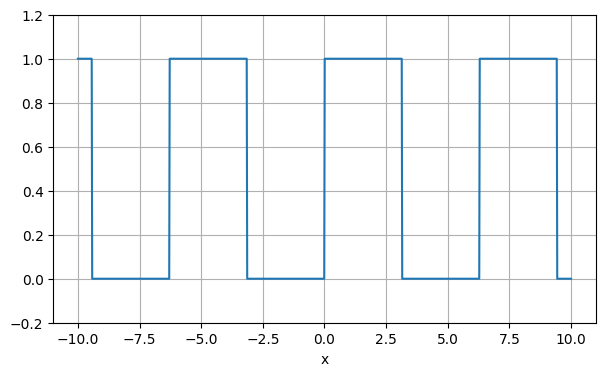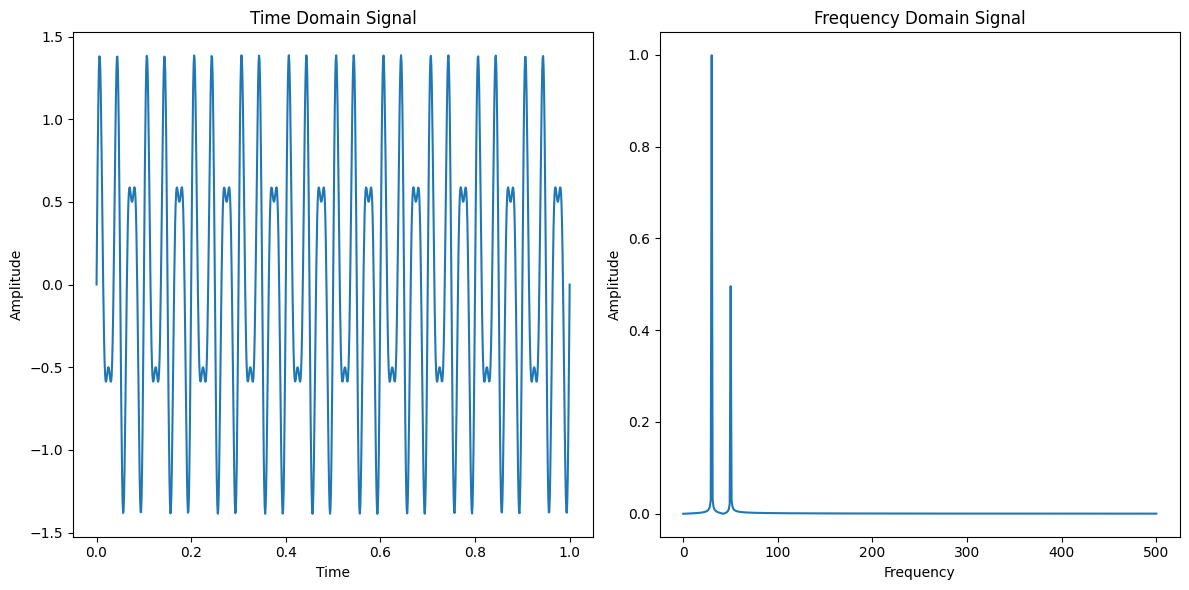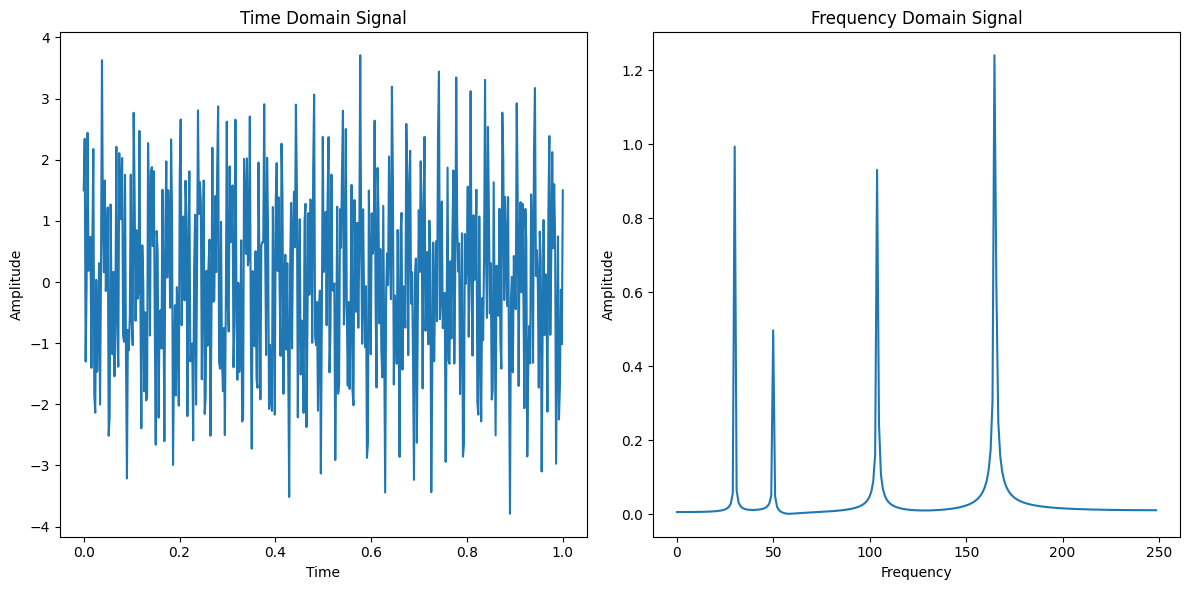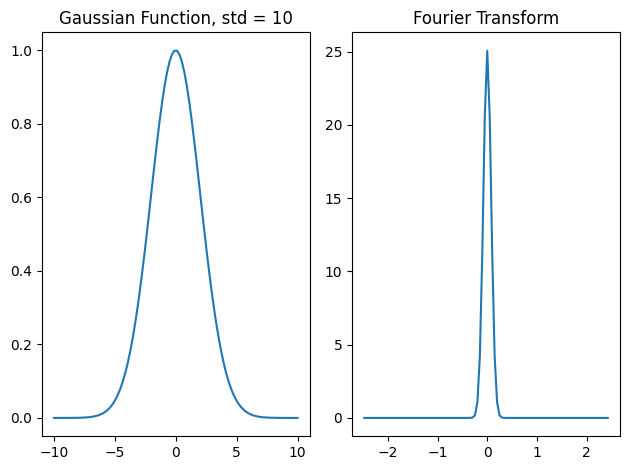Fourier Transforms and Quantum Mechanics#
Fourier Series#
The Fourier series enables us to represent periodic functions as infinite sums. Particularly, it represents functions as a sum of weighted \(\sin\) and \(\cos\) functions.
This is possible, since the \(\sin\) and \(\cos\) functions form a complete orthogonal set (basis functions). The Fourier series for a function \(f(x)\) with a period of \(2{\pi}\) is given by:
Fourier Series
Fourier coeffiecients and orthogonality of sin and cos functions
Using the orthogonality property of the cos and sin functions we can determine an expression for the coefficients of the Fourier Series. By integrating the Fourier Series over the interval [-\({\pi}\),\({\pi}\)], we can determine an expression for \(a_0\). Over this interval, the sums will vanish, as we are intergrating the \(\sin\) and \(\cos\) functions over one period. Thus, we are left with
Therefore, by carrying out the integral we find the expression for \(a_0\) to be
From this, it is clear that the \(\frac{a_0}{2}\) term in the series represents the mean of the function \(f(x)\) over the period. In order to determine the \(a_n\) coefficients we must multiply the series by \(\cos(mx)\), for a positive integer \(m\), and integrate over its period. The series becomes
Due to the orthogonality property of the \(\sin\) and \(\cos\) functions, the only term that does not vanish on the right-hand side is \(\int_{-{\pi}}^{\pi}a_n\cos(nx)\cos(mx)dx\) for \(m=n\). Solving for \(a_n\) we get
This is consistent with the expresion for \(a_0\) for \(n=0\). Thus the 1/2 factor included on the \(a_0\) term is there to maintain this consistency between \(a_0\) and \(a_n\).
To determine the values of the \(b_n\) coefficients we multiply by \(\sin(mx)\). Similarly to the \(a_n\) coefficients, due to the orthogonality property, the only term that does not vanish on the right-hand side is \(\int_{-{\pi}}^{\pi}b_n\sin(nx)\sin(mx)dx\) for \(m=n\). Thus, solving for \(b_n\)
Square function and Gibbs phenomenon#
Now that we have introduced the Fourier Series lets look at an example, the positive square wave. This is defined as
Let’s plot this function.
Show code cell source
# Define a function to create a square wave
import numpy as np
import matplotlib.pyplot as plt
import matplotlib
def square(x, period):
# Create array with zeros
y = np.zeros(len(x))
# Change zeros to 1 based on a given period
# in radians (e.g. 2pi, 3pi)
for i in range(len(x)):
if (x[i]/(period)) % 1 < 0.50:
y[i] = 1.0
return y
N = 1000 # Number of points
x = np.linspace(-10.0, 10.0, N)
plt.figure(figsize=(7,4))
plt.plot(x, square(x, 2*np.pi))
plt.grid(True)
plt.ylim(-0.2, 1.2)
plt.xlabel('x')
plt.show()

Now let’s try to express the square wave as a Fourier Series. Firstly we need to calculate the coefficients using the above expressions. Carrying out the calculations we find
Now let’s plot the Fourier Series for \( n=10, n=50,\) and \(n=100\).
Show code cell source
# Define the cos and sin terms of the Fourier series
def cosTerm(n):
# Always zero except for n=0
if n==0: return 1.0
return 0.
def sinTerm(n):
if n%2: # n modulo 2 = 1 (True) then Odd
ret = 2. / (n* np.pi)
else:
ret = 0.
return ret
def fourier(n,x):
#a_0 term, remember 1/2
sum = cosTerm(0)/2.0 * np.ones(len(x))
#all other terms
for i in range(1, n+1):
sum += sinTerm(i)*np.sin(i*x) + cosTerm(i)*np.cos(i*x)
return sum
fig, axes = plt.subplots(1, 3, figsize=(14,4), sharey=True)
# Loop over each subplot
for idx, i in enumerate([10, 50, 100]):
ax = axes[idx]
ax.plot(x, fourier(i, x), label="n = %g" % (i))
ax.plot(x, square(x, 2*np.pi), color="black", label="square wave")
ax.legend(loc="upper right", fontsize="small")
ax.set_xlabel("x")
ax.set_ylim(-0.2, 1.2)
plt.tight_layout()
plt.show()

Fourier Transform#
We can remember that the Euler transform converts \(e^{ix}\) into sine and cosines, so we can also write the Fourier series in complex numbers:
And the coefficients would then be:
We might not like the use of complex numbers, but it’s obviously the same Fourier series. We can also simplify the notation a bit, by introducing the “wave number”
where \(\lambda\) is the wavelength. If we let the length \(L\) go to infinity, then:
the coefficients are:
Fourier transform:
The original \(f(x)\) is the inverse Fourier transform:
Fourier analysis of time-series data#
Periodic data#
We’re going to construct an array of time points. Then we’ll set up a function with two sine waves:
We can use
scipy.fftpackto perform the “fast Fourier transform” (FFT). The resulting “x” variable will be in frequency - so the limit is defined by the \(dt\) we had. We cannot find a higher frequency than that time resolution. (In short, if we expected to have GHz signals, we’d need short time resolution.)
Show code cell source
import scipy.fftpack
# Number of sample points
N = 1000
# Sample spacing
delta = 1.0 / 1000.0
# Time array
t = np.linspace(0.0, delta * N, N)
# Time domain signal
y = np.sin(30.0 * 2.0 * np.pi * t) + 0.5 * np.sin(50.0 * 2.0 * np.pi * t)
# Compute the Fourier Transform
xf = np.linspace(0.0, 1.0 / (2.0 * delta), N // 2)
yf = scipy.fftpack.fft(y)
# Plot both time domain and frequency domain side by side
fig, (ax1, ax2) = plt.subplots(1, 2, figsize=(12, 6))
# Time domain plot
ax1.plot(t, y)
ax1.set_xlabel("Time")
ax1.set_ylabel("Amplitude")
ax1.set_title("Time Domain Signal")
# Frequency domain plot
ax2.plot(xf, 2.0 / N * np.abs(yf[:N // 2]))
ax2.set_xlabel("Frequency")
ax2.set_ylabel("Amplitude")
ax2.set_title("Frequency Domain Signal")
# Show the plots
plt.tight_layout()
plt.show()

Notice it’s not a perfect reconstruction. We only put in two specific frequencies, so we’d expect to see two different lines. But if we don’t have exactly perfect waves when we cut off the time signal, there will be a bit of peak width.
The time-domain signal can be as complicated as we want. Here’s an example with 4 frequencies - note that it doesn’t matter the phase indicated by sine or cosine functions - they’re both periodic.
Noisy periodic data#
Show code cell source
import numpy as np
import matplotlib.pyplot as plt
from scipy.fftpack import fft
# Generate sample data
t = np.linspace(0.0, 1.0, 500)
y = np.sin(30.0 * 2.0 * np.pi * t) + 0.5 * np.cos(50.0 * 2.0 * np.pi * t)
y = y + 1.5 * np.sin(165.0 * 2.0 * np.pi * t) + np.cos(104 * 2.0 * np.pi * t)
# Compute the Fourier Transform
N = len(t)
yf = fft(y)
xf = np.fft.fftfreq(N, t[1] - t[0])[:N//2]
# Plot both time domain and frequency domain side by side
fig, (ax1, ax2) = plt.subplots(1, 2, figsize=(12, 6))
# Time domain plot
ax1.plot(t, y)
ax1.set_xlabel("Time")
ax1.set_ylabel("Amplitude")
ax1.set_title("Time Domain Signal")
# Frequency domain plot
ax2.plot(xf, 2.0 / N * np.abs(yf[:N//2]))
ax2.set_xlabel("Frequency")
ax2.set_ylabel("Amplitude")
ax2.set_title("Frequency Domain Signal")
# Show the plots
plt.tight_layout()
plt.show()

Noisy non-periodic data#
Whatever signals we put into our time function will come out from our FFT … at least given the time resolution we start with. (We can’t find 800 Hz frequencies in this example).
Also, the time signal doesn’t need to be completely periodic… a “chirp” can also work where the signal intensity drops over time.
Show code cell source
# Apply the exponential decay to the time domain signal
y = y * np.exp(-2 * t)
# Compute the Fourier Transform after the decay
yf = fft(y)
# Plot both time domain and frequency domain side by side
fig, (ax1, ax2) = plt.subplots(1, 2, figsize=(12, 6))
# Time domain plot after exponential decay
ax1.plot(t, y)
ax1.set_xlabel("Time")
ax1.set_ylabel("Amplitude")
ax1.set_title("Time Domain Signal with Exponential Decay")
# Frequency domain plot after exponential decay
ax2.plot(xf, 2.0 / N * np.abs(yf[:N//2]))
ax2.set_xlabel("Frequency")
ax2.set_ylabel("Amplitude")
ax2.set_title("Frequency Domain Signal with Exponential Decay")
# Show the plots
plt.tight_layout()
plt.show()

Notice that while the peak heights changed a bit, the relative intensities and peak areas remain unchanged. So if you’re doing spectroscopy, you’ll need a few wave repeats, but it doesn’t need to be a “continuous wave” spectra - useful if you’re worried about applying a high-intensity beam (e.g. x-ray, etc.)
Fourier transoform and the uncertainty relation#
Define the Square Function to represent \(\psi(x)\): Start with a square function (or rectangular pulse) that has a width \(w\) and height 1, centered around zero. This function can be represented as:
Fourier Transform gives us \(\psi(p)\): The Fourier transform \(\hat{f}(k)\) of a square function is a sinc function:
where \(\text{sinc}(x) = \frac{\sin(x)}{x}\). This shows how the Fourier transform spreads out as the width of the square function changes.
Uncertainty Relation
The uncertainty principle states that the product of the standard deviations of a function and its Fourier transform is bounded by a minimum value!
Here, \(\Delta x\) is the width of the function (related to the spread in position), and \( \Delta k\) is the spread of the Fourier transform (momentum space). As the width \(w\) of the square function decreases, the sinc function’s spread in the Fourier domain increases, demonstrating the uncertainty relation.
In quantum mechanics using De Broglie relation we can recover uncertaintly relation \(k=2\pi/\lambda = 2\pi p/h = p/\hbar\)
Show code cell source
import matplotlib.pyplot as plt
from matplotlib.animation import FuncAnimation
from IPython.display import HTML
import numpy as np
# Define the square function
def square_function(x, w):
return np.where(np.abs(x) <= w / 2, 1, 0)
# Fourier transform of the square function (sinc function)
def fourier_transform_square_function(k, w):
return w * np.sinc(k * w / (2 * np.pi))
# Define x and k ranges
x = np.linspace(-5, 5, 1000)
k = np.linspace(-20, 20, 1000)
# Set up the figure and axes for animation
fig, axes = plt.subplots(2, 1, figsize=(8, 8))
# Initialize the plots
line1, = axes[0].plot([], [], lw=2)
axes[0].set_ylim([-0.1, 1.1])
axes[0].set_title("Square Function")
line2, = axes[1].plot([], [], lw=2)
axes[1].set_ylim([-0.5, 2.5])
axes[1].set_title("Fourier Transform")
# Set the x-axis limits
axes[0].set_xlim(x.min(), x.max())
axes[1].set_xlim(k.min(), k.max())
# Initialization function
def init():
line1.set_data([], [])
line2.set_data([], [])
return line1, line2
# Animation update function
def update(w):
# Compute the square function and its Fourier transform
sq_func = square_function(x, w)
ft_sq_func = fourier_transform_square_function(k, w)
# Update the data for both plots
line1.set_data(x, sq_func)
line2.set_data(k, ft_sq_func)
return line1, line2
# Create the animation
ani = FuncAnimation(fig, update, frames=np.linspace(0.1, 5.0, 100), init_func=init, blit=True)
plt.close(fig) # Prevents static display of the last frame
HTML(ani.to_jshtml())
Fourier transforms of Gaussian functions#
A Gaussian function is defined as
where \(\sigma\) is the standard devation of the Gaussian. The Fourier transform of a gaussian is another Gaussian such that
Thus, we can see that as the Gaussian function gets broader, its Fourier Transform gets narrower. To illustrate this, let’s plot the Gaussian and its transform for two different standard deviations.
Show code cell source
from scipy import signal
g1 = signal.gaussian(100, std = 10)
t = np.linspace(-10, 10, len(g1))
plt.subplot(1,2,1)
plt.plot(t, g1)
plt.title('Gaussian Function, std = 10')
FT_omega = np.fft.fftfreq(len(g1), t[1] - t[0])
FT = np.fft.fft(g1)
FT_omega = np.fft.fftshift(FT_omega)
FT = np.fft.fftshift(FT)
plt.subplot(1,2,2)
plt.plot(FT_omega, abs((FT)))
plt.title('Fourier Transform')
plt.tight_layout()
plt.show()
g2 = signal.gaussian(100, std = 1)
t = np.linspace(-10,10, len(g2))
plt.subplot(1,2,1)
plt.plot(t, g2)
plt.title('Gaussian Function, std = 1')
FT_omega = np.fft.fftfreq(len(g2), t[1] - t[0])
FT = np.fft.fft(g2)
FT_omega = np.fft.fftshift(FT_omega)
FT = np.fft.fftshift(FT)
plt.subplot(1,2,2)
plt.plot(FT_omega, abs((FT)))
plt.title('Fourier Transform')
plt.tight_layout()
plt.show()


Delta Function#
The delta function, \(\delta(t)\), is defined as
Carrying out the transform we see that Fourier Transform of the delta function is actually a constant, such that
Let’s plot the function and its transform.
Show code cell source
from scipy import signal
imp = signal.unit_impulse(100, 'mid') # creates the delta function
t = np.linspace(-5, 5, 100)
plt.subplot(1,2,1)
plt.plot(t, imp)
plt.title('Delta Function')
FT_omega = np.fft.fftfreq(100, t[1] - t[0])
FT = np.fft.fft(imp)
plt.subplot(1,2,2)
plt.plot(FT_omega, abs(FT))
plt.title('Fourier Transform')
plt.ylim([0,1.2])
plt.tight_layout()
plt.show()

Free Electron and Delta Function Duality#
A general wavefunction can be expanded as a superposition of momentum eigenstates:
where \(e^{ikx}\) are eigenfunctions of the free-particle Hamiltonian and form a complete orthogonal basis. The coefficient \(\phi(k)\) gives the amplitude of each momentum mode.
For a localized particle, \( \phi(k)\) is broad — many momenta combine to form a narrow spatial peak.
For a free electron with definite momentum \(k_0\),
\[ \phi(k) = \delta(k - k_0), \]so that
\[ \psi(x) = e^{ik_0x}. \]Conversely, for a localized particle at \(x_0\):
\[ \psi(x) = \delta(x - x_0) ;\Rightarrow; \phi(k) = \frac{1}{\sqrt{2\pi}} e^{-ikx_0}. \]
Thus, a free electron (plane wave) is a single momentum component spread uniformly in space, while a localized delta function in space is an infinite superposition of plane waves. This Fourier duality expresses the position–momentum uncertainty relationship.

